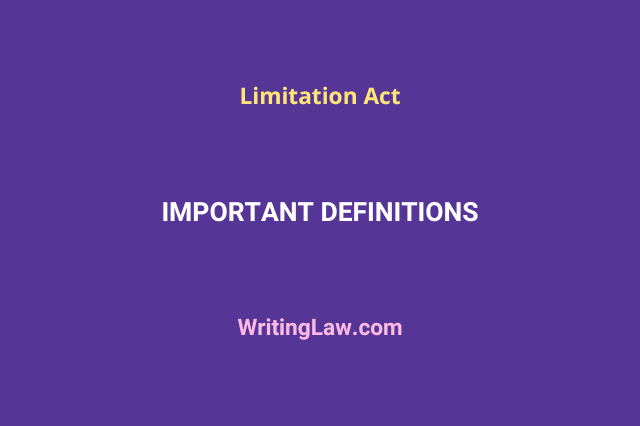
Understanding the general meaning of definitions is considered to be the most vital part of knowing the law and getting a grasp of the Bare Acts. Therefore to make this journey easier, this law note discusses all the definitions provided under the Limitation Act, 1963.
Important Definitions of Limitation Act
Section 2 of the Limitation Act of 1963 provides fourteen definitions. Let us discuss those definitions one by one.
1. Applicant
It is defined under section 2(a) of the Limitation Act. Applicant includes a:
(a) Petitioner
(Petition: A proposal given to the court that demands justice is a petition. And the person by whom it is given is a petitioner.)
(b) Any person from whom or through whom an applicant derives the right to apply as an applicant. Example: the guardian on behalf of a minor.
(c) Any person whose estate is represented by the applicant as executor (the person appointed by any person as representative of any estate after his death), administrator (a person appointed by the court as the representative of any state), or other representatives.
Therefore, it can be said that an applicant is a person who proposes something that has been made in writing.
2. Application
Section 2(b) of the Limitation Act defines the term application. In a general sense, an application is a proposal to the court that discloses the willingness of the applicant in any regard. As per section 2(b), it includes a petition as well.
3. Bill of exchange
A bill of exchange is a negotiable instrument (that is, a transferable document – say money) to pay a sum of money to a particular person on a particular date. According to section 2(c) of the Limitation Act, it includes a Hundi and a cheque.
4. Bond
Section 2(d) of the Limitation Act defines bond. It refers to an instrument where a person obliges himself to pay a certain sum of money to another person on the condition that if a certain specified act is performed or is not performed, the obligation shall become void.
5. Defendant
Section 2(e) of the Limitation Act defines the term defendant. Defendant is a person who defends the suit. It also includes any person from or through whom the defendant derives his liability to be sued. It also includes any person whose estate is represented by the defendant as an executor, administrator or other representatives.
6. Easement
Section 2(f) of the Limitation Act defines easement. It refers to the right to use the immovable property of another person for self-benefit in order to use one’s own property more comfortably or easily. It is a default right that arises without forming a contract, or it’s the right which does not arise from the contract. It includes the right to way. Right to way means a path across a private piece of land which may be used as a public way.
7. Foreign Country
Foreign country is defined under section 2(g) of the Limitation Act. It means any country other than India.
8. Good Faith
Good faith is defined under section 2(h) of the Limitation Act. It refers to the act done with due care and attention.
9. Plaintiff
Generally, the plaintiff refers to a person who brings the suit. According to section 2(i) of the Limitation Act, a plaintiff is a person who brings a suit or has a right to sue. It also includes a person from or through whom a plaintiff derives his right to sue, or any person whose estate is represented by the plaintiff as executor, administrator or other representatives.
10. Period of Limitation
Section 2(j) of the Limitation Act defines the terms period of limitation as well as prescribed period.
Period of limitation refers to the time period which is prescribed for any suit, appeal or application by the Schedule of the Limitation Act, 1963.
Prescribed period refers to the period of limitation computed according to the provisions of the Limitation Act.
11. Promissory Note
Section 2(k) of the Limitation Act defines a promissory note, where the maker of the instrument promises to pay a certain specified sum of money to another person in a limited period of time.
12. Suit
Section 2(l) of the Limitation Act defines a suit. It provides that suit does not include an appeal or an application.
13. Tort
Section 2(m) of the Limitation Act defines tort. Tort refers to a civil wrong, and it does not include a breach of contract or a breach of trust.
14. Trustee
Section 2(n) of the Limitation Act provides an exclusive definition of trustee, which says that trustee does not include a Benamidar, a mortgagee remaining in possession after a mortgage has been satisfied, or a person in a wrongful possession without a title.
Read Next:
1. Important Sections of Limitation Act
2. Limitation Act PDF Download
- What Is Anticipatory Breach of Contract Under Contract Act? - 13th July 2024
- Who May File Written Statement (With Its Time Limit and Rules) - 31st May 2024
- Who Is a Legal Representative? - 30th May 2024







